Septic arthritis of the sacroiliac secondary to suppurative pyomyositis
DOI:
https://doi.org/10.1016/j.rccot.2022.08.006Keywords:
Pyomyositis, Staphylococcus aureus, Bacteremia, Arthritis infectiousAbstract
Pyomyositis is a subacute suppurative bacterial infection of muscle, caused by hematogenous spread and sometimes accompanied by the formation of abscesses. Although, it is a disease classically observed in tropical areas, in recent years an increase in its incidence has been described in temperate countries, especially in immunosuppressed people.
Its most frequent etiological agent is Staphylococcus aureus. The most common locations are the quadriceps, buttocks, and iliopsoas, the association with septic arthritis and osteomyelitis being exceptional.
In the pediatric population, it usually affects healthy people and athletes, and its appearance is related to intense physical exercise or minor trauma that, in many cases, can go unnoticed. The clinical presentation of acute pyomyositis is usually insidious, and can occur without fever, but with local symptoms such as pain, swelling, and functional limitation. Drainage of the abscess, followed by the administration of antibiotics leads to complete recovery. Primary pyomyositis is rare, and the diagnosis is delayed due to the deep location of the muscle and because the symptoms can confuse the diagnosis with septic arthritis of the hip.
We present this case due to the difficulty of its diagnosis and the complications derived from the delay in its diagnosis.
Downloads
References
Scharschmidt TJ, Weiner SD, Myers JP. Bacterial Pyomyositis. Curr Infect Dis Rep. 2004;6:393-6, http://dx.doi.org/10.1007/s11908-004-0039-9.
Méndez Echevarría A, Baquero Artigao F, Velázquez Fragua R, García Ascaso MT, Merino Mu˜noz R, del Castillo Martín F. Piomiositis paravertebral resuelta con tratamiento antibiótico exclusivo [Paravertebral pyomyositis resolved by exclusive antibiotic treatment]. An Pediatr (Barc). 2004;60:597-8, http://dx.doi.org/10.1016/s1695-4033(04)78337-x.
Abbati G, Abu Rumeileh S, Perrone A, Galli L, Resti M, Trapani S. Pelvic Pyomyositis in Childhood: Clinical and Radiological Findings in a Tertiary Pediatric Center. Children (Basel). 2022;9:685, http://dx.doi.org/10.3390/children9050685.
Stevens DL, Bisno AL, Chambers HF, Dellinger EP, Goldstein EJ, Gorbach SL, et al. Infectious Diseases Society of America. Practice guidelines for the diagnosis and management of skin and soft tissue infections: 2014 update by the Infectious Diseases Society of America. Clin Infect Dis. 2014;59:e10-52, http://dx.doi.org/10.1093/cid/ciu444.
Ovadia D, Ezra E, Ben-Sira L, Kessler A, Bickels J, Keret D, Yaniv M, Wientroub S, Lokiec F. Primary pyomyositis in children: a retrospective analysis of 11 cases. J Pediatr Orthop B. 2007;16:153-9, http://dx.doi.org/10.1097/BPB.0b013e3280140548.
Bickels J, Ben-Sira L, Kessler A, Wientroub S. Primary pyomyositis. J Bone Joint Surg. 2002:2277-86. https://doi.org/10.2106/00004623-200212000-0002
Bocchini CE, Hulten KG, Mason EO Jr, Gonzalez BE, Hammerman WA, Kaplan SL. Panton-Valentine leukocidin genes are associated with enhanced inflammatory response and local disease in acute hematogenous Staphylococcus aureus osteomyelitis in children. Pediatrics. 2006;117:433-40, http://dx.doi.org/10.1542/peds.2005-0566.
Taksande A, Vilhekar K, Gupta S. Primary pyomyositis in a child. Int J Infect Dis. 2009;13:e149-51, http://dx.doi.org/10.1016/j.ijid.2008.08.013.
Llorente Otones L, Vázquez Román S, I˜nigo Martín G, Rojo Conejo P, González Tomé MI. Piomiositis en los ni˜nos: no sólo una enfermedad tropical [Pyomyositis in children: not only a tropical disease]. An Pediatr (Barc). 2007;67:578-81, http://dx.doi.org/10.1016/s1695-4033(07)70807-x.
Murai M, Moriyama H, Hata E, Takeuchi F, Amemura- Maekawa J. Variation and association of fibronectin-binding protein genes fnbA and fnbB in Staphylococcus aureus Japanese isolates. Microbiol Immunol. 2016;60:312-25, http://dx.doi.org/10.1111/1348-0421.12377.





